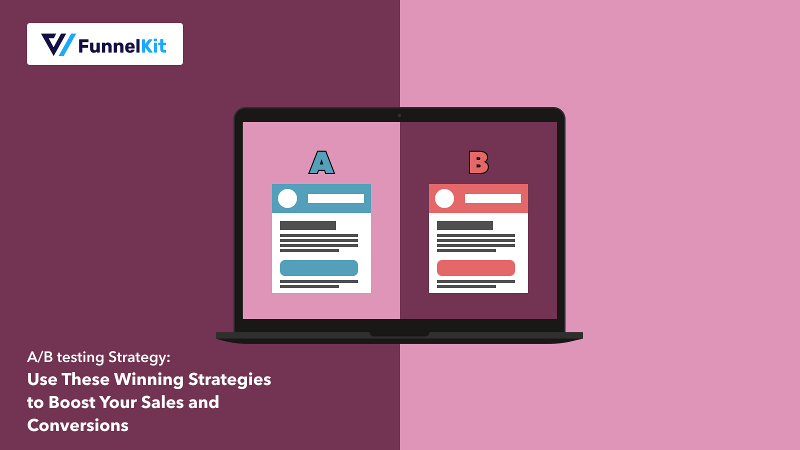
The right A/B testing strategy can skyrocket your sales by ensuring you offer your audience exactly what they want.
In this competitive world of digital marketing, relying on guesswork to understand your audience's demands is not an option. And A/B testing is your solution for this.
A/B testing can boost your online store’s conversion rate by around 12% to 15% by helping you to understand what resonates with your audience.
While the perks of A/B testing are great, most people don’t know how A/B tests work and how to perform A/B tests on web pages.
In this blog, you will learn about different types of A/B testing, how to build an A/B testing strategy, and how to perform an A/B test on sales funnel pages right from your WordPress dashboard.
So, let’s begin.
Contents
A/B testing, also known as split testing, is a digital marketing experiment where you simultaneously test different versions of a variable (web page such as sales page, upsell page, etc.) on different segments of website visitors to determine which variant wins.
In simpler terms, A/B testing involves presenting one version (A) of a marketing content piece to one portion of your live audience and another version (B) to another portion. It’s recommended to divide the audience into equal portions.
This way, you can compare the conversion rate of the different versions over a specific period of time and determine the more effective one.
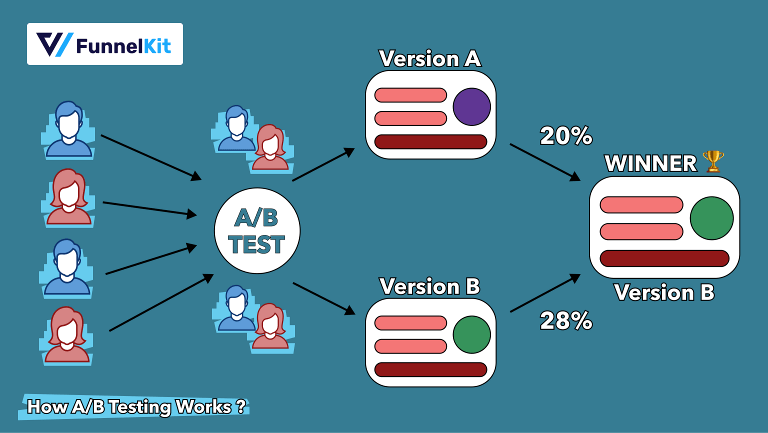
Let’s learn about the most common types of A/B testing:
In A/B testing, aka Split testing, two distinct variations, typically labeled as version A and version B, are created for a specific webpage or element. These variations are presented to different segments of the target audience simultaneously, and their performance is measured to determine which version performs better in terms of achieving the desired objective.
For example, a website might conduct an A/B test by creating two different versions of the checkout page or upsell page with a different copy or different image of the product, etc. And then run the two versions equally among the audience.
By monitoring the conversion rates or click-through rates for each version, the website can determine which copy/image resonates better with its audience and drives more desired actions.
A/B/n testing is an extension of the A/B testing concept. It allows marketers to test more than two variations simultaneously. This way, businesses can compare multiple versions of a webpage or element to identify the most effective variation.
For instance, an e-commerce website might conduct an A/B/n test by simultaneously testing three different landing pages. This could include one with a large product image as version A, another with a video showcasing the product as version B, and a third with an image slideshow as version C.
Multivariate testing, often referred to as MVT, is a contrast to A/B and A/B/n testing. This type of testing allows marketers to test combinations of different elements within a single webpage or element rather than totally different versions of the same webpage.
For example, a photography website might conduct an MVT by testing different combinations of headlines, images, and call-to-action buttons on their homepage.
Overall, all these scientific methods, such as A/B testing, A/B/n testing, and multivariate testing, are essential to make data-driven decisions, ultimately leading to improved conversion rates and business success.
Let’s learn a little bit more about the advantages of A/B testing.
A/B testing your web pages is crucial for several compelling reasons:
Not just conversion rates, you can increase your website traffic, achieve lower bounce rates, decrease cart abandonment, etc., based on the goals you want to achieve.
Now that you know how beneficial implementing an A/B testing strategy is, let’s learn how to create one.
The primary objective of A/B testing is to set a clear goal and iteratively test different variations to achieve that goal.
The first step in creating an effective A/B testing strategy is to know your goals right from the beginning. For example, do you want more traffic? Do you want to lower the bounce rate? Boost the conversion rate? Increase click-through rates? Or Increase the average order value by A/B testing the upsell page?
Once you have defined your goal, proceed to the next step, which involves conducting research and creating a detailed buyer persona. Your buyer persona essentially serves as the blueprint for your A/B testing strategy.
It will give you essential information to generate testing variants. By understanding your target audience through the buyer persona, you can tailor your A/B tests to align with their preferences.
When you know your target audience, you can create two A/B test variants. Treat the variant as the solution that will make your target audience take the needed action to reach that goal.
For example, you can create one sales page version with video testimonials and another version with still images with ratings and reviews.
Gathering an adequate amount of data for statistical analyses is vital in A/B testing. A small sample size may not provide enough information, and conducting a study with an excessively large sample could be impractical. Therefore, it’s important to choose your sample size carefully.
Additionally, maintaining a balanced representation of both solutions is important for optimal results. If variant A is tested with a specific number of users, ensure that a similar number of users test variant B. This balanced approach enables you to gather meaningful feedback and identify statistical significance in your test results.
Once you have an adequate amount of data, it’s time to analyze and formulate results. For example, if your aim was to boost the average order value and test two different versions of an upsell template. Version 1 resulted in 20% conversion whereas version 2 resulted in 28%, then clearly, version two with 28% is the winning variant.
Just getting the results isn’t enough; you need to take action based on the results. Once you know what works better, you can make the changes to your marketing strategy accordingly.
Remember, A/B testing shouldn’t be a one-time thing, as there is no limit to how much you can improve your marketing strategy. So it’s recommended to keep experimenting with the A/B testing strategy to continuously improve the shopping experience.
Now let’s check how you can A/B test your marketing sales funnel to improve your conversion rate.
The sales funnel is often considered the backbone of marketing, and the more optimized your sales funnel is, the better conversion rate you can achieve.
To A/B test the sales funnel, we will use the ultimate sales funnel builder - FunnelKit Funnel Builder.
Creating the sales funnel is also easy breezy with this WordPress plugin as it comes with many pre-built templates that you can just import and use in a few steps.
The best part is you can create the sales funnel using your favorite page builder because FunnelKit deeply integrates with all the popular page builders, such as Elementor, Divi, Gutenberg, Oxygen, etc.
It has a built-in testing feature that lets you A/B test all the steps of a sales funnel, such as the sales/landing page, checkout page, upsell page, and thank you page.
FunnelKit provides a user-friendly interface that allows you to easily create different test variants and allocate an audience among them.
First, let’s Install and activate both FunnelKit Funnel Builder Free and Pro versions.
Navigate to FunnelKit ⇒ Funnels from the WordPress admin panel and click the ‘Create New Funnel’ button.

From the list of sales funnels, hover on the one you like and click on Preview. We are choosing “Frizty” here.
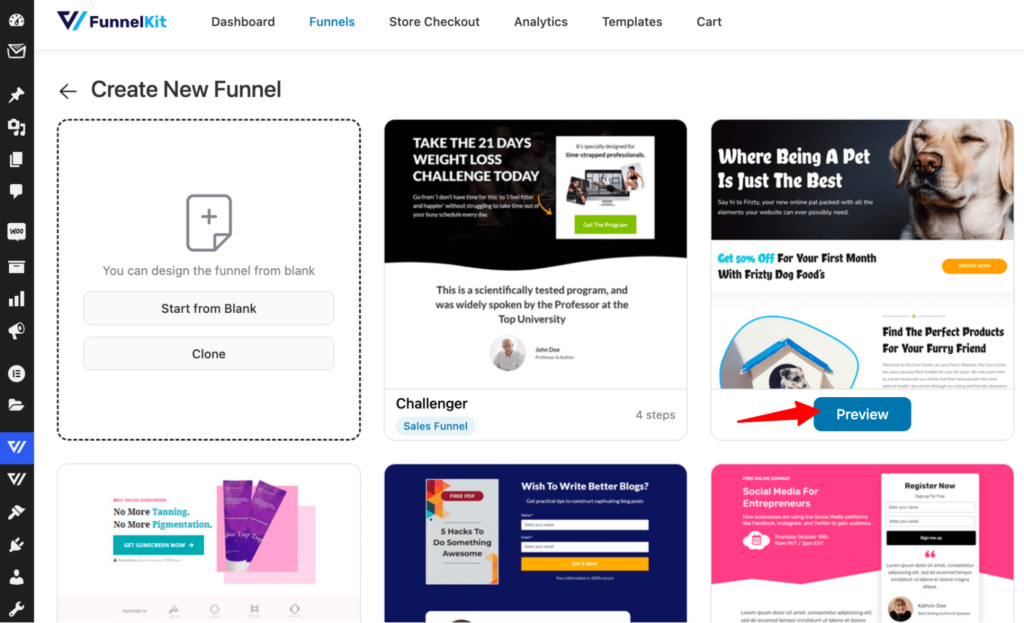
To import the funnel, click on the “Import This Funnel” button and provide a name. Finally, clicking on ‘Add’ will import your sales funnel with the upsell template.
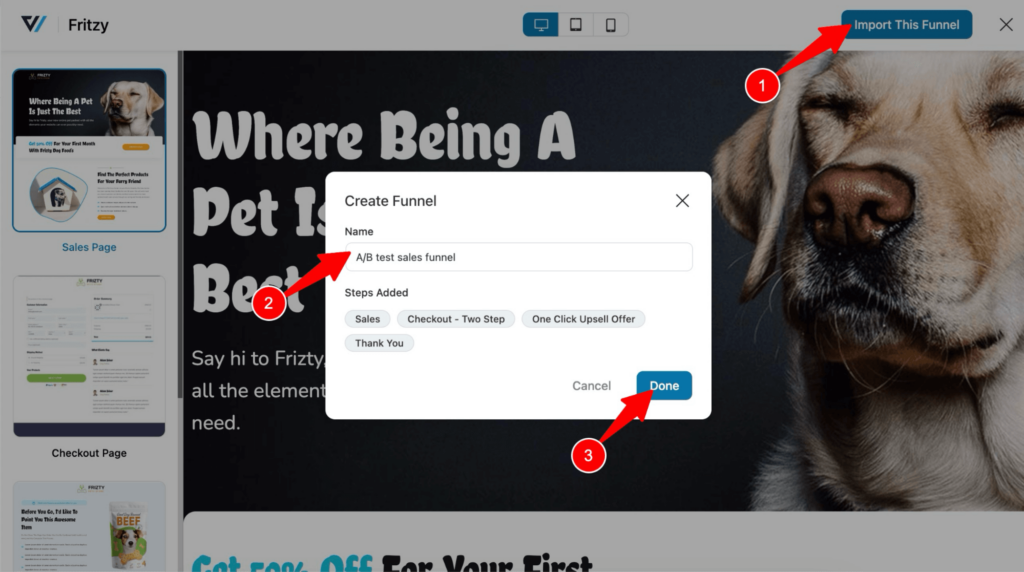
Now you can add the base products and upsell products to the template and customize the content. For more details, check these resources on how to customize
After you are done customizing your sales funnel, let’s move to the next step to A/B test the funnel steps.
For more details on how to create a sales funnel in WooCommerce, read our blog on WooCommerce sales funnel.
As mentioned earlier, you can individually A/B test different pages of your sales funnels. Let’s start with the landing page.
To start, click on the A/B test option next to a landing page.

Now click on Create A/B test to create A/B test variants for the landing page.
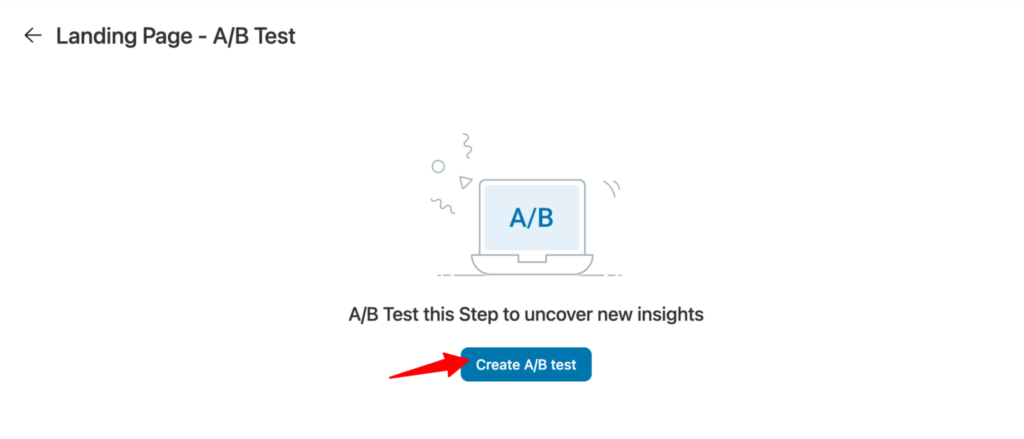
Since you imported a landing page, you should see one variant here. To add a second variant, click on the “Add Variant” button.

Now you will find two options.
We are going with the first option here.
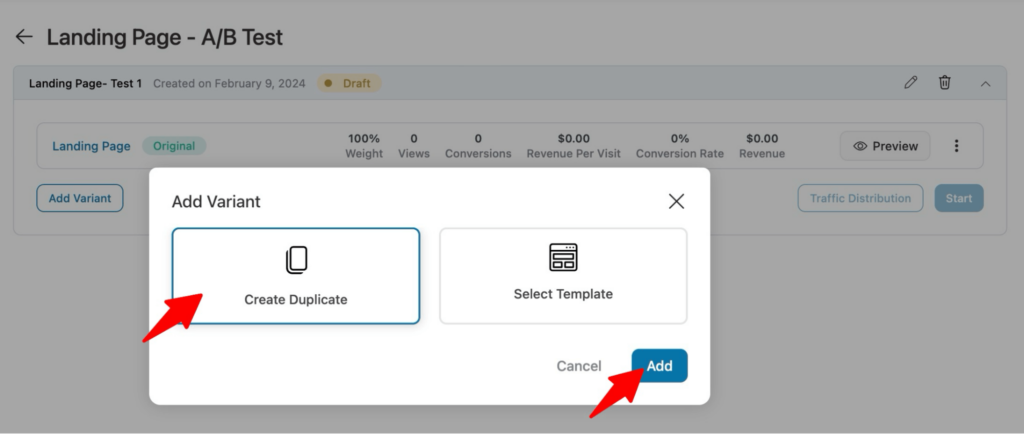
Now to edit the content of the second variant, click ‘Edit’ from the options you will get after clicking on the three dots.
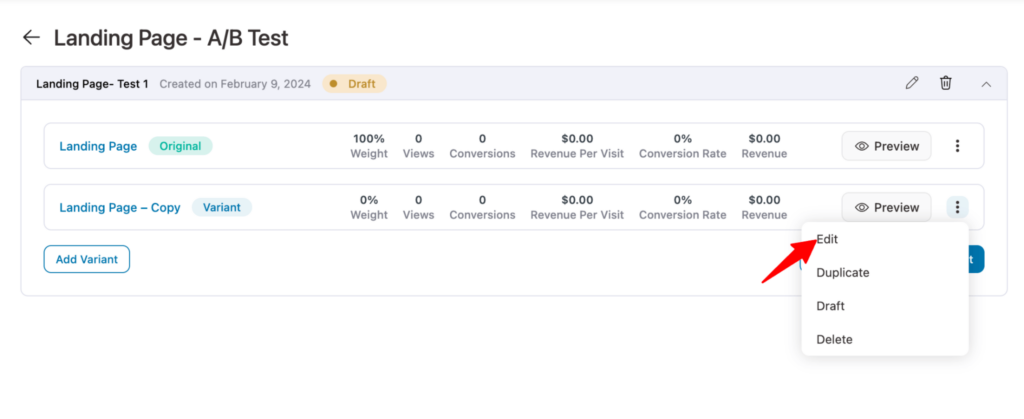
For example, we are changing the top heading. You can make more changes according to your A/B testing strategy.
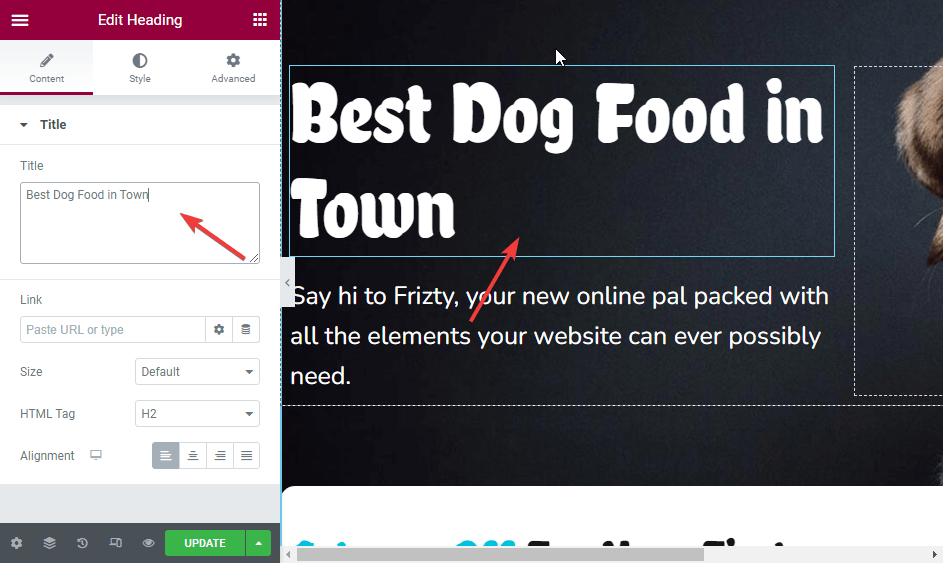
We made another change by highlighting the discount amount so people are motivated to click on the CTA. Here are both of the landing pages.
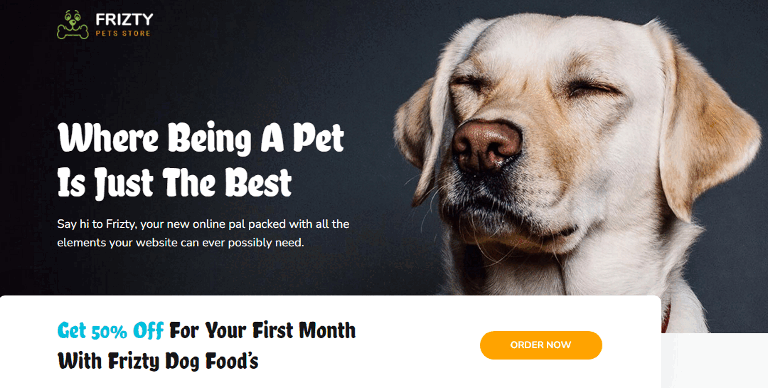
After you are done making two variants of the landing page, it’s time to distribute the traffic equally. For that, click on “Traffic Distribution,” and provide the values and click on Confirm. For optimal results, we’ll assign 50% of traffic to each of these variants.
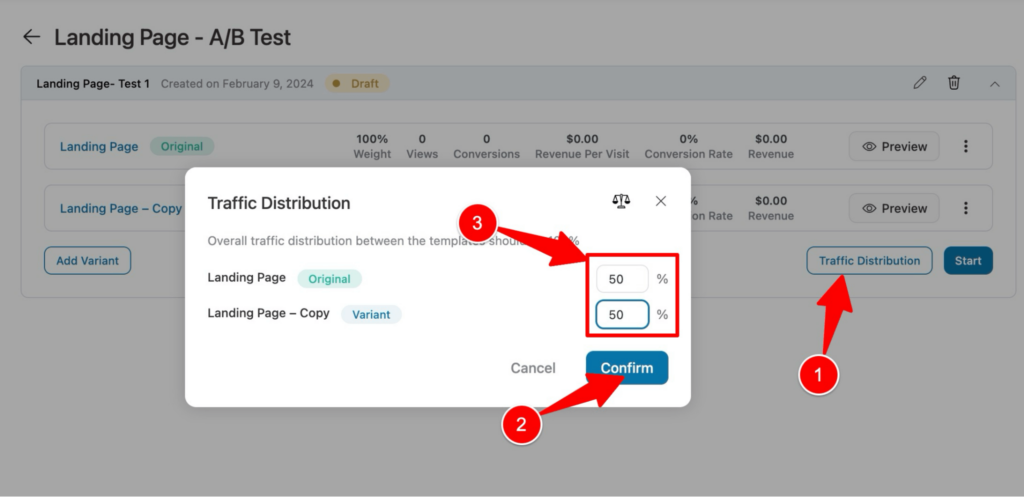
Now click on the “Start” button to start A/B testing the landing page variants. After that, check the confirmation box and click on "Start Now".
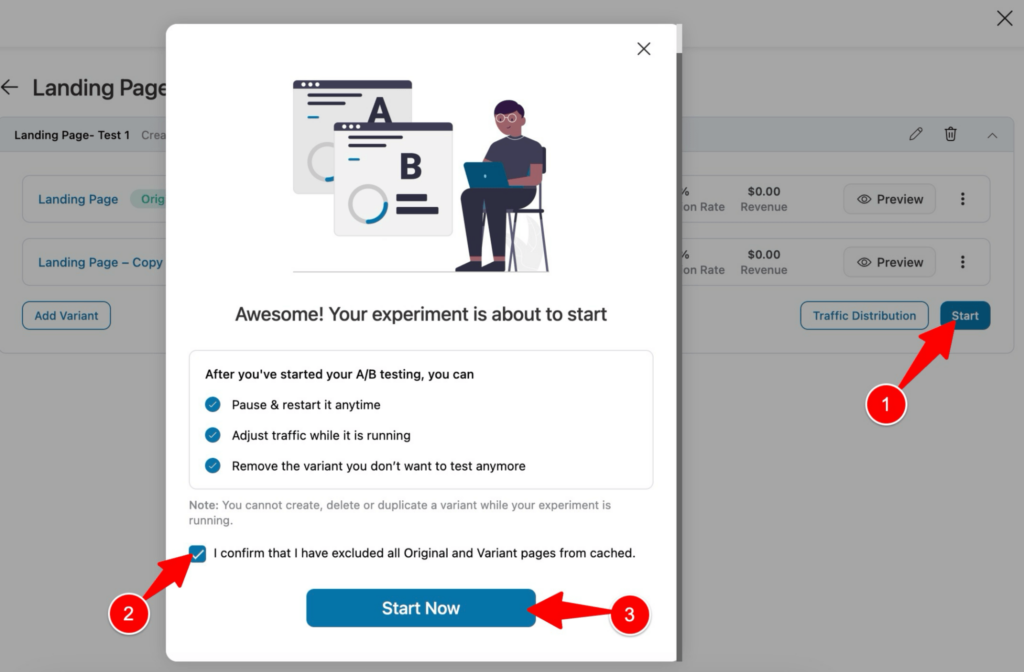
This will start the A/B testing for the landing page.
🔔 You can also read our blog on how to create a WooCommerce landing page.
After you set up the A/B testing strategy for the landing page, it’s time to do the same for the checkout page. The checkout page plays a crucial role in the sales funnel as it is where potential customers make their final decision on whether to complete the purchase or not.
Now to give an idea, you can A/B text the checkout page with different types of variants, such as one-page, multi-step, or Shopify-style checkout, which will help you to determine which version converts best.
By experimenting with different checkout page designs, you can optimize the user experience and increase conversion rates, ultimately improving the success of your sales funnel.
Let’s say you have imported a single-page checkout, and now for the second variant, you want to create a checkout page with multi-step checkout.
Now, when you go to the A/B testing option and click on Add New Variant, choose the option “Select Template from another funnel” and click on Next.
Note: make sure you set up a base product for both variants.
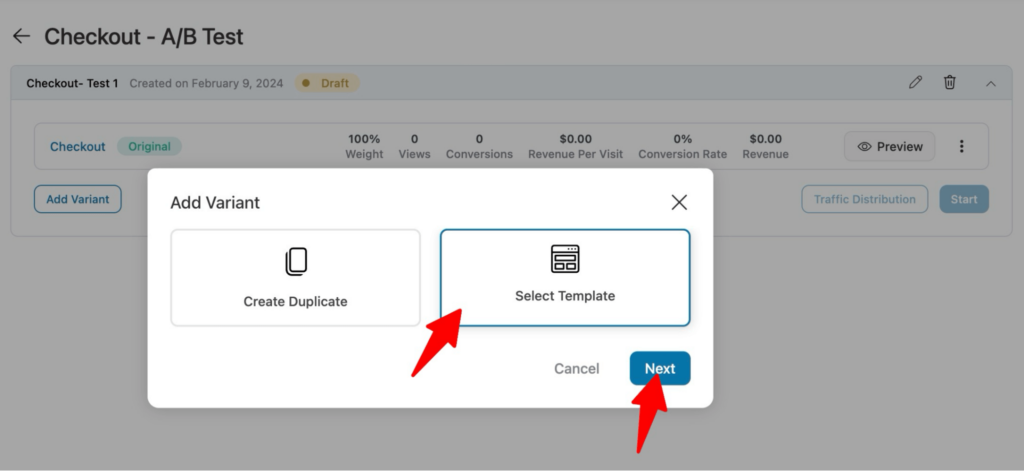
Now, choose the multi-step checkout from the existing funnel.
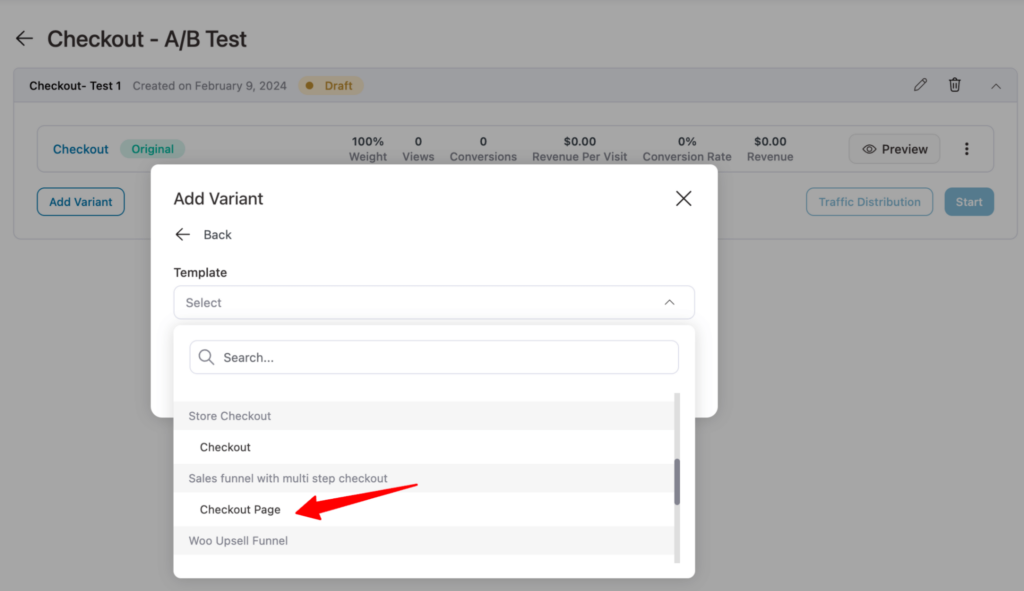
After selecting the template, click on Add.
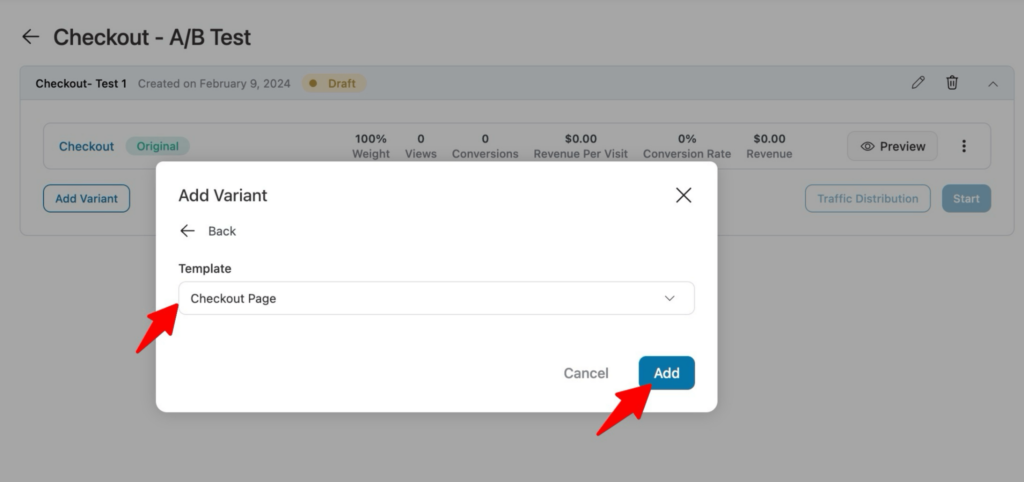
After that, again distribute the traffic and start the A/B test.
Here are the two versions we chose for two different variants to test the checkout page.
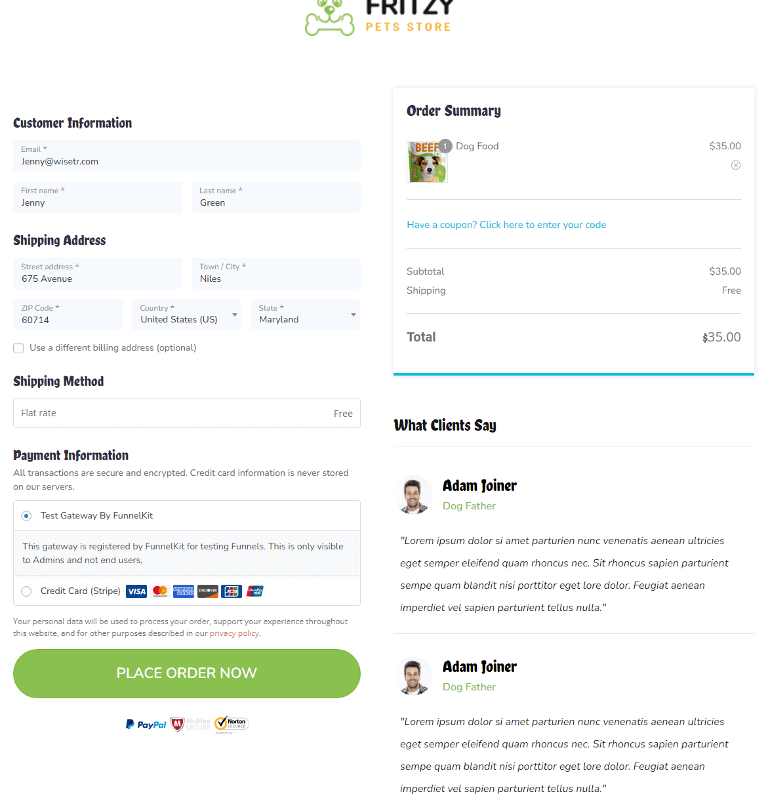
Note: Similarly, you can offer single/multiple order bumps in the two variants.

If the goal of your A/B testing strategy is to increase average order value, then you must find out what works as a one-click upsell offer for you.
You can try changing different elements of the same template to create two different variants or use two different templates. Make your decision based on the buyer persona you created.
Or, you can offer different product recommendations as your upsells. For that, you need to create a second variant using the same original template. After that, edit that variant and, on the offer tab, change the product.
Note: Ensure both products are relevant to the base product.
First, delete the existing product by clicking on the “Delete” icon.
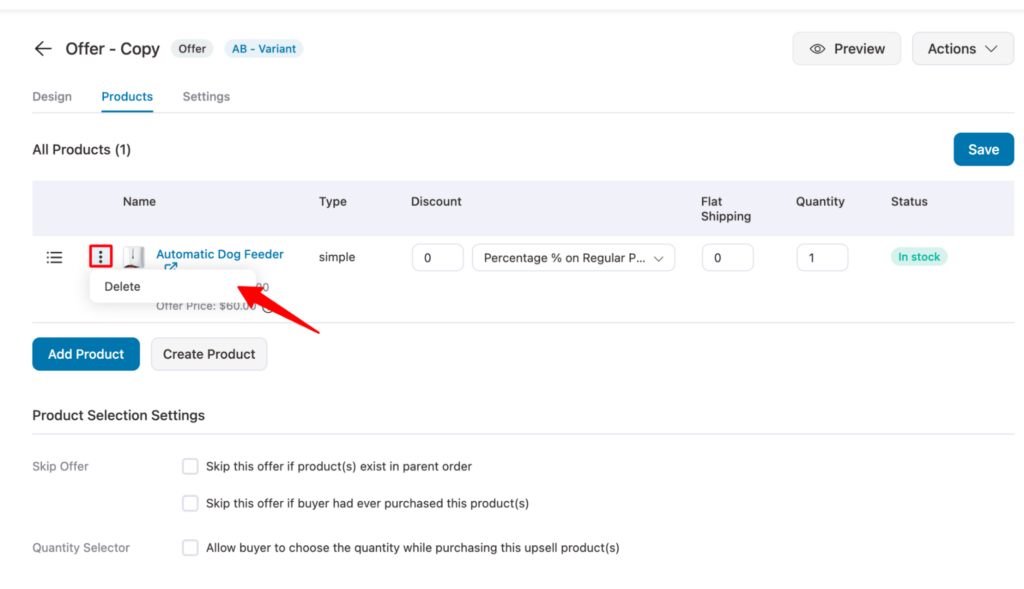
After deleting, make sure you add the new product to your upsell copy.

Here is how the two upsell variants look with the same template:
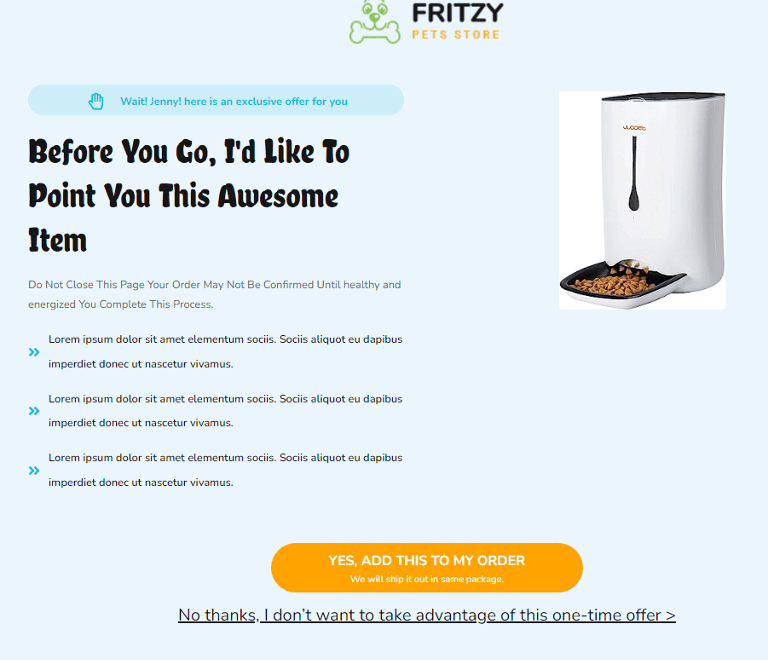
Again, make sure to distribute the traffic and start the A/B testing.
Thank you pages are important to retain your customer. You don’t want your customers to be one-time buyers. So, your A/B testing strategy should also include testing the thank you page.
Like you have created variants and added traffic for the other sales funnel pages, make sure to do the same for the thank you page as well. And, of course, don’t forget to start the A/B testing process.
🔔 You can also read our blog on how to customize a thank you page.
After running a test for some time and gathering adequate data, you can declare a winning variant and transfer all the traffic to it to get good conversions. For example, based on the testing results, here we have declared the first variant of the checkout page as the winner as it has a higher conversion rate and more revenue.
Note: You can declare a winner based on the metrics you set in your A/B testing strategy after comparing the testing results.
To declare a winner click on the "Declare Winner" button and then click on Winner for the variant you want to declare as the winner. Here, the first variant is our winner.
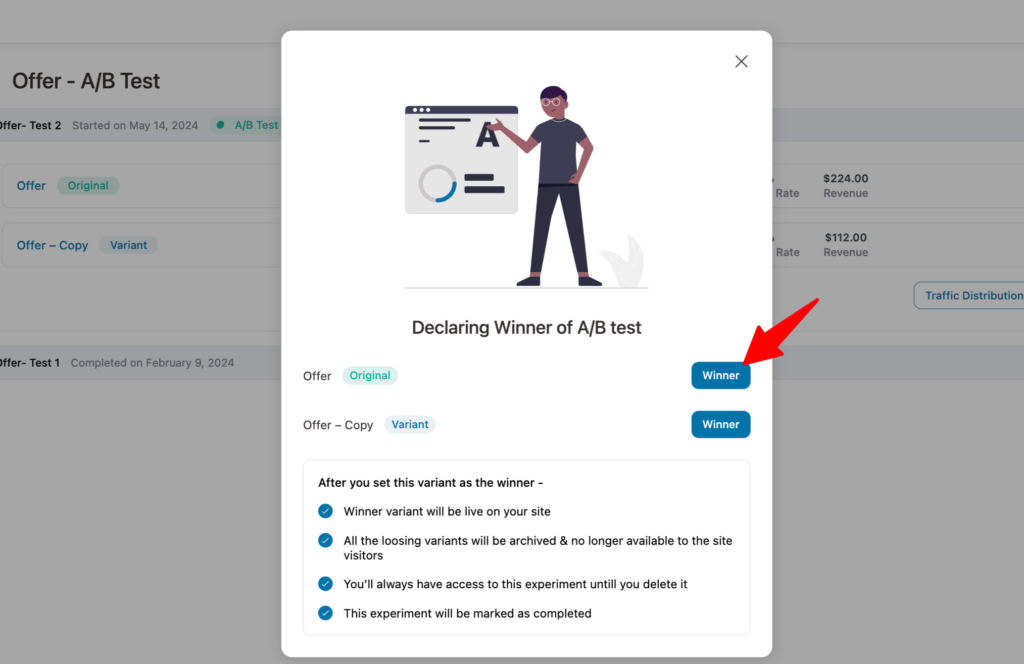
Similarly, once you have enough data, declare the winner for all the steps of the sales funnel.
Here is our winner for the upsell A/B testing.

And that’s it! This is how easily you can A/B test your sales funnel using the FunnelKit Funnel Builder.
Implementing an A/B testing strategy in your sales funnels can be highly effective in boosting the revenue for your online store. However, remember A/B testing is not a one-time thing; based on the positive results, you should continuously A/B test different elements and combinations and refine them to ensure your user gets the best shopping experience possible.
The key is to do your research before setting up your A/B test and act accordingly based on the A/B test results.
For implementing the A/B testing strategy, FunnelKit is there to help you with its extensive features and user-friendly interface. Moreover, FunnelKit also provides the A/B testing result in a neat and efficient way so you can easily decide the winner.
So, are you ready to implement an A/B testing strategy with FunnelKit?